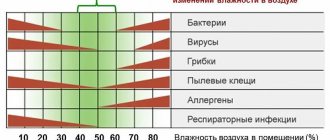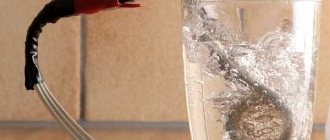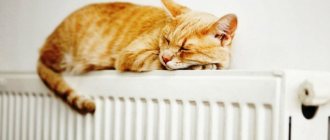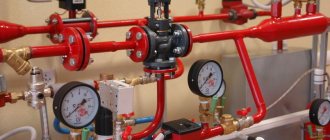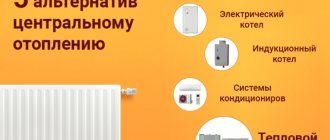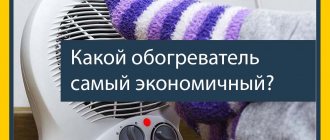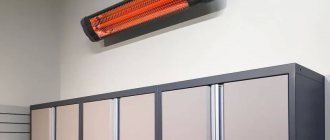Legislative solution to the issue
With the onset of cold weather, the issue of warmth at home is especially acute. Owners of private houses are luckier - homeowners independently set the beginning and end of the heating season, humidity and temperature conditions. But residents of apartment buildings depend on the state, because the standards for heat supply in an apartment building, humidity and temperature conditions are set out in Appendix No. 2 to SanPiN 2.1.2.2645-10. These standards apply only to residential premises; non-residential rooms or industrial premises do not meet the established standards.
What factors influence temperature
The warmth of room air depends on many factors. The reasons for its decline are varied - problems in the boiler room, worn-out heating networks, old internal communications, negligent attitude of owners and tenants towards their housing.
External factors affecting central heat supply:
- Unsatisfactory performance of the heat supply company. The reasons are fuel saving by thermal engines and reduced pressure. In this case, the medium entering the heating network is initially poorly heated.
- High wear and poor quality thermal insulation of external and internal networks that are unable to retain heat.
- Failure to comply with SNIPs and other building standards during construction. Buildings with thin walls are difficult to warm up. The situation is typical for new buildings.
- Wear and tear of housing. In old housing stock, the engineering systems are very worn out, so the coolant in them cools down.
Indoor factors affecting temperature:
- Low level of heat conservation - open windows in the entrance, doors without closers and return springs, open attics and basements. The house is simply cooling down.
- The poor condition of the pipes inside the apartment building - depressurization, air pockets and blockages reduce the temperature level.
- Problems with the return line installed for the outflow of waste media. In such cases, circulation in the heating system is disrupted, which leads to low temperature readings.
- Actions of residents who make unauthorized changes to utility networks.
Why can it be cold in the apartment:
- The batteries installed are too small and cannot cope with the task. Instead, it is advisable to install modern powerful models that warm even a large room well.
- The regulation of the radiators is disrupted - in such a situation, they call a specialist who will bring everything back to normal.
- Heat sources are blocked by furniture or other objects that interfere with heat exchange. A reshuffle will save the situation.
- Old pipes that require replacement. They are replaced with new ones - metal, plastic, metal-plastic.
- Old, cracked window frames. They are being replaced with plastic structures.
- Poor thermal insulation. Insulating the walls will save the situation.
All these situations can be eliminated without contacting utility services.
Temperature and Humidity Requirements
In accordance with the requirements of SanPiN, the following values for temperature and humidity are established:
| Residential category | Air temperature in the room, °C | Resulting temperature, °C | Relative humidity, % | |||
| optimal | acceptable | optimal | acceptable | optimal | acceptable | |
| Indicators for the cold season | ||||||
| Heating standards for apartments: living room | 20-22 | 18-24 | 19-20 | 17-23 | 45-30 | 60 |
| The same in the areas of the coldest five-day period (minus 31 °C and below) | 21-23 | 20-24 | 20-22 | 19-23 | 45-30 | 60 |
| Kitchen | 19-21 | 18-26 | 18-20 | 17-25 | Not standardized | |
| Toilet | 19-21 | 18-26 | 18-20 | 17-25 | ||
| Bathroom or combined bathroom | 24-26 | 18-26 | 23-27 | 17-26 | ||
| Inter-apartment corridor | 18-20 | 16-22 | 17-19 | 15-21 | 45-30 | 60 |
| Lobby, staircase | 16-18 | 14-20 | 15-17 | 13-19 | Not standardized | |
| Storerooms | 16-18 | 12-22 | 15-17 | 11-21 | ||
| Values for the warm season | ||||||
| Living room | 22-25 | 20-28 | 22-24 | 18-27 | 60-30 | 65 |
How to take measurements
If you have any doubts about the insufficient heat of the coolant, measurements must be taken.
They are made at several points:
- The air in the room is measured in the center of the room. The distance from the batteries must be at least 0.5 meters, from the floor - at least 0.6 meters.
- Pipes. To measure them, you need to attach a thermometer to the product at the entrance to the apartment or measure it with a beam on the pipe itself in close proximity to the pipe. It is also advisable to measure the temperature of the pipe leaving the room.
- Batteries. It is better to measure the radiator in several places, especially if there are many sections. Measurements must be taken in the first and last sections. The temperature is measured in the same way as on the pipe.
- Coolant. To measure, you need to open the tap, if available, and drain a small amount of liquid into the container. When descending into the stream, you need to place a thermometer.
Utility services are primarily responsible for the result, that is, for the temperature in the room. But measurements according to this scheme will show where the gap exists and why it is cold or hot in the apartment.
If the room temperature is lower than normal, but all technological standards are met, then a complaint should be filed with the local management organization. It is also necessary to complain if the coolant temperature is less than the required one.
Advice. It is better to measure the temperature in the batteries by residents together in different apartments. In case of obvious violation, a collective complaint has greater effect than a private one. And, conversely, if the standards are met in one apartment, but not in another, this is an indicator of a malfunction in the heating system.
Competent measurements, analysis of the operation of devices in the room and timely contact with the management organization will help you quickly and clearly understand the cause of insufficient heat and correct it.
Unified heating standards for apartment buildings
The established standards for heat supply to apartments are standardized. This means that the values are defined in general as the average temperature throughout the hospital. But officials have provided additional rules and exceptions.
Firstly, exceptions apply to rooms with a corner location in the building layout. In the corner room, the temperature should be two degrees higher than the approved standard. The requirement is due to the fact that the angular location implies freezing of the walls.
The temperature requirements at night are more gentle: between 00:00 and 05:00 the temperature can drop to 4 degrees Celsius. This is due to the fact that at night human life processes slow down and the need for heat is somewhat reduced.
Using our table, check whether the heating standard in an apartment building is met in 2022 in your apartment:
| Residential category | Minimum temperature for the cold season (heating standards) |
| Living room of an apartment, house or dormitory | 18 (20 in corner room) |
| The same in areas with the coldest five-day temperature (probability 0.92) minus 31 °C and below | 20 (22 in the corner room) |
| Apartment and dormitory kitchen, vat | 18 |
| Drying cabinet for clothes and shoes in the apartment | – |
| Bathroom | 25 |
| Individual restroom | 18 |
| Combined toilet and bathroom area | 25 |
| The same, with individual heating | 18 |
| Common washroom | 18 |
| Shared shower | 25 |
| Shared restroom | 16 |
| Dressing room for cleaning and ironing clothes, washroom in the dormitory | 18 |
| Lobby, common corridor, hallway in an apartment building, staircase | 16 |
| Lobby, common corridor, staircase in the dormitory | 18 |
| Laundry room | 15 |
| Ironing and drying rooms in dormitories | 15 |
| Storage rooms for storing personal belongings and sports equipment; household and linen in the hostel | 12 |
| Isolation room in a dormitory | 20 |
| Elevator machine room | 5 |
| Garbage collection chamber | 5 |
What to do if there is no heating?
In the event that GOST for heating in an apartment is far from its norm, it is necessary to determine the cause of cold radiators. To do this, it is better to call representatives of the relevant service , since they can simultaneously record the temperature in living quarters.
If the problem is poor quality maintenance of the home heating system by heating network workers, then all the burden of troubleshooting will fall on the organization. At the same time, residents of the house must either be recalculated for heating if the radiators do not heat enough, or record the period when they were completely cold and be exempt from payment.
Thus, the law on heating of apartment buildings (2017) guarantees residents protection if utility services fail to comply with their duties .
Any application from them must be considered as soon as possible, after which a special commission comes and documents the discrepancies.
Knowing how many degrees the heating should be in the apartment, and at what time the system is turned on, each owner can independently determine whether the indicators comply with heating standards in the apartment and take measures if this is not the case.
With the arrival of autumn cold, when thermometer readings drop to 8-10 degrees Celsius, and real winter begins in the northern regions of Russia, the use of the word form “heating season” becomes appropriate. And during this period, it makes sense to understand the basic standards for coolant temperature in the heating system, which are regulated by the state.
When the heating season arrives, owners of private houses and cottages independently open the valves and nozzles of boiler systems. In apartment buildings, things are a little different, and residents are forced to wait impatiently for a plumber from the management company, who will start the heating system and allow people to feel confident in the future.
It is no secret that in multi-apartment buildings of economy class, heating is carried out through a centralized heat supply system. All heating lines are hidden in the basement, and the supply of coolant is regulated using water valves, behind which there are sump tanks and risers. Passing through the last nodes, the liquid is supplied to batteries and radiators, which start heating the surrounding space.
The number of valves must correspond to the number of risers. The presence of these elements allows one apartment to be disconnected from the general system for the duration of any repair work. The spent coolant ends up in the return pipe and also partially penetrates the hot water supply network.
The creation of liquid for a heating installation occurs at a thermal power plant or in a boiler room. Heat supply standards in an apartment building are regulated by the relevant building rules: the coolant must be heated to 130−150 degrees Celsius. When drawing up current standards, it is necessary to take into account the parameters of the ambient air. For example, for the Southern Urals, minus 32 degrees should be taken into account.
Read more: Deputy Head of VET job description
To prevent the liquid from boiling, it is supplied to the network under a pressure of 6-10 KGS. However, this is only a theoretical statement. In fact, a significant part of the heating mains operate at 95-110 degrees Celsius, which is explained by their poor condition.
The concept of “norm” is very loose. Heating radiators never warm up to the temperatures possessed by the coolant. In this case, the energy-saving function will be assigned to another part of the system - the elevator unit, which is a jumper between the direct and the return pipe. According to current standards, the temperature of the liquid in the system through the return pipe in winter can be 60 degrees Celsius.
During the cold winter season, it is time to heat the apartments.
According to the law of the Russian Federation, we are provided with high-quality central heating at subsidized prices.
What should you really expect during the heating season? How high quality and effective it will be.
Heating standards for private households
There are no requirements for how the owner can heat his home. There is no special heating standard in a private home, and everyone regulates the heat according to their own desire and well-being.
But it is important to understand that if several families live in one household and the heating is common, then the same requirements will have to be observed. For such cases, central heating standards are mandatory.
Despite the lack of standards, no one has canceled the requirements for the design of a boiler room for a private house and fire safety. Before starting heating equipment in a private household, you will have to coordinate the boiler room with government agencies.
Possible causes of low temperature
Reasons why the air temperature in the apartment can be significantly reduced:
- Incorrect design during the construction of the entire house, when the heating system does not cope with the task. Or building codes were violated.
- Gaps in windows, doorways, balcony frames; the balcony is not insulated.
- Draft.
- Insufficient wall thickness, at which freezing occurs and, as a consequence, a decrease in temperature standards in the living room.
- If the apartment is on the ground floor, there may be basements with storage rooms underneath, which require constant ventilation. And then the best solution is to install a “warm floor”.
- Deterioration of the heating system in the house.
- Location of the room. In winter, a corner apartment and an apartment on the ground floor will always be a little cooler than an apartment located in the center of the house.
- Incorrect operation of the heating system, for example, air lock in the batteries.
- The heat supply is not at sufficient temperature, the batteries are barely warm. We are talking about a service of inadequate quality and a violation of heating standards.
- Repair work in case of accidents in the cold season, during which the temperature in the battery can significantly decrease.
Heating season in Russia
The heating season is a period of the cold season during which residential buildings are provided with heat or thermal energy according to established heating standards. There is no specific duration established in Russia. Everything depends on weather conditions.
The standard heating season lasts in Russia from October to April. But each region has its own temperature and weather, so officials have established rules for determining the beginning and end of the heating season:
- The beginning is established on the condition that the average daily street temperature is minus 8 degrees or below for five days in a row;
- Completion is established provided that there is warm weather outside the window of 8 degrees and above for five days in a row.
Preparation for the heating season begins one and a half to two months before it starts. Preparatory activities include:
- checking the integrity of heating devices and structures;
- checking the performance of thermal equipment of boiler houses;
- checking meters and metering devices;
- commissioning works;
- checking for compliance with the standard water temperature in heating radiators in residential premises, etc.
Residents are notified in advance about preparations for the heating season by posting relevant notices on their entrance doors.
IMPORTANT!
Preparation is a mandatory stage before the start of the heating season, since the check allows you to prevent emergency situations, identify the reasons for exceeding heat consumption standards in the MDC, and provide residents with quality service.
In private households, the owner is responsible for commissioning work. But gas and utility companies conduct annual fitness inspections of equipment. If violations are detected, the owner will receive an order requiring them to eliminate the comments.
What laws regulate the supply of heat?
According to clause 5 of Part II of Decree No. 354 of May 6, 2011, heating is turned on when the average temperature outside drops below + 8° within 5 days. They stop supplying heat when in the spring, for five days in a row, the average temperature outside per day is + 8°.
In the central regions of the country, including Moscow, this happens most often from October 1 to October 15. Submission ends approximately April 15th. Dates may change due to weather conditions.
Unlike the capital, in the southern and northern latitudes the parameters are completely different. For example, in Magadan this period lasts from September 9 to June 16, and in Sochi - from November 15 to April 15. The exact start date of heat supply is always determined by the average outdoor temperature.
The beginning and end of the heating season are fixed in regulations of the local administration. Such a document is necessary for the correct calculation of heat supply standards and compensation for housing and communal services for beneficiaries.
Legislative acts do not apply to residential buildings with autonomous heating. Residents decide for themselves when and how to heat.
How is heat payment calculated?
Any public service is provided in our country on a paid basis. Owners of private houses usually receive receipts for gas - the supplier calculates the volume of gas consumed and issues an invoice.
In urban and suburban apartment buildings (MKD), payment is calculated differently, and we are talking about centralized heating. The rules for calculating the standard for heating an apartment building are enshrined in Decree of the Government of the Russian Federation dated May 23, 2006 No. 306 (as amended on September 29, 2017). According to formula 18, the calculation of what the standard Gcal per m² is based on the total heat consumption, the duration of the heating season and the heated area.
In some multi-family houses, individual gas equipment is installed, and payment for heat is made by analogy with private houses - based on the volume of gas consumed.
Heating price standards per square meter are determined individually, depending on the utility service provider’s prices per Gcal. The calculation of the monthly payment is determined depending on the area of the heated room (apartment) and the price factor.
What types of batteries are there?
The room temperature depends not only on the coolant itself, but also on the number of sections in the battery.
Cast iron products, which are rare in modern homes, have the best heat transfer. Their heat transfer is 70%. For other products: aluminum, bimetallic and steel, this figure is 50%.
The power of the battery itself is measured in watts. According to SNiP 41-01 per 1 sq. meter of area should be at least 10 watts.
The power of one battery section depends on the material:
- Cast iron – 100 W
- Aluminum – 200 W
- Bimetal – 150 W
- Steel – 120 W
Depending on these indicators, calculations are made for the installation of heating devices.
Important! If the power of the devices is clearly less than required, that is, they have a small number of sections, then it is useless to blame the utilities due to the insufficient amount of heat.
An inspection of the premises by technicians will reveal this. According to the law, responsibility for the equipment inside the apartment lies with the owner or the person who owns the apartment under a social tenancy agreement.
It’s cold in the apartment, how to deal with it
Non-compliance with heating standards must be reported to the supplier immediately. It is enough to send a written application to the company's dispatch service or contact us by phone. The dispatcher of the receiving party is obliged to record the application and send a team for inspection. In general, the deadline for an on-site inspection is no later than 2 hours from the receipt of a complaint from dissatisfied residents. The time can be additionally agreed upon with the applicant in case the owners are in the apartment and can open the door for measurements.
A sample of such a statement
The visiting team must take appropriate measurements according to the established regulations. Then a report on the results of the control is drawn up. The effective act indicates:
- date and time of inspection;
- venue (apartment address);
- composition of those present;
- measurement methods;
- tools and devices used for measurements;
- results (temperature around the perimeter of the apartment, humidity, and so on).
The act is drawn up in two copies, one for the team and the applicant. If you were not given a copy of the act, take a photo of the document with your phone or camera.
Based on the results of the inspection, work is carried out to identify and eliminate problems with the heating system. If the utility service provider has not taken any action, then contact the regulatory authorities - Rospotrebnadzor or the prosecutor's office. The inspection report of the visiting team will be proof of violations.
Responsibility of utilities
After receiving a complaint, representatives of the resource supply company must notify the subscriber of the date and time of temperature measurements in the apartment. At this point, the applicant is obliged to ensure his presence and admission to the apartment.
Based on the results of measurements, a report is drawn up describing all the parameters. One copy of the act is given to the applicant against signature, the second is stored in the resource supply company.
If it is confirmed that the temperature in the apartment does not meet the norm during the heating season, the resource supplying organization is obliged to make a recalculation for the entire period of supply of services of inadequate quality in accordance with the conditions of clauses 101, 111, 112 of the Rules, approved by Decree of the Government of the Russian Federation dated 05/06/2011 No. 354 (hereinafter referred to as Rule 354).
Rules for recalculating heating fees in case of non-compliance with standards
If heating standards are not met, then residents have the right to demand compensation in the form of recalculation of utility bills. But before counting the money, let us recall that heat suppliers have the right to legal interruptions in the supply of thermal energy within the following values:
- no more than 24 hours within 1 month (calculated in total);
- no more than 16 hours at a time, provided that the air temperature in living rooms is from +12 °C and above, up to the standard temperature indicated in the tables above;
- no more than 8 hours at a time, provided that the air temperature in living rooms is from +10 °C to +12 °C;
- no more than 4 hours at a time, provided that the temperature in the living room varies from +8 to +10 °C.
If time limits are exceeded, then residents have the right to demand a reduction in heating payments according to the standard by 0.15% for each hour. To receive a recalculation, non-compliance with standards must be documented. That is, an act of examining the temperature in a living room is mandatory. The amount of compensation is calculated from the moment this act is signed.
About the author of the article
Natalya Evdokimova Accountant-expert, practical experience - more than 15 years.
Author of articles in online media on accounting, taxes, and personnel issues.
Ways to normalize temperature conditions
Low temperatures in pipes are fraught with the appearance of mold on the walls and ceiling. However, it does not pose a threat to the heating system, unlike overheating, as mentioned above. There are a number of precautions to prevent damage:
- Heating system safety group. These are three partings having one common body.
Photo 2. Safety group for the heating system, consisting of three devices: pressure gauge, air vent, check valve.
- Safety valve . As you know, water increases in volume when heated, thereby increasing pressure. When it goes beyond normal limits, the valve is activated, normalizing it.
- Pressure gauge. A device for measuring pressure inside the system.
- Automatic air vent. Serves to remove air trapped in the system.
- Mixing unit. Installed to match temperatures. Installed between the supply pipe and the return pipe. When the water heats up, it creates excessive pressure on the valve, thereby opening it. This way the water mixes and cools.
- Electronic heating control unit. The unit measures the temperature of the water in the system in its various sections. In case of overheating, it gives a signal to reduce the power of the water heater.
Heat calculation rules
To determine the amount of heat supplied, three different formulas are used; they are presented in Appendix of Resolution No. 354. They are used for the following cases:
- There are no metering devices in the building (there is neither a general nor an individual heat consumption meter), and they cannot be installed due to the design features of the heating system or other objective reasons. The formula is as follows: Pi = Si x NT x Tt , where Pi is the fee, Si is the housing area, NT is the established standard for thermal energy consumption, and Tt is the accepted tariff. For example, if the housing has an area of 45 sq. meters, the region has adopted a standard of 0.018 gigacalories per 1 sq. m., and the tariff is 1950 rubles per 1 gigacalorie, the owner will have to pay 1579.50 rubles if only the period of operating heating is paid.
- A common meter (GPU) is installed in the house, but individual metering devices are missing or not installed in all rooms. The formula is as follows: where Vd is the reading of the general building meter, Si is the area of a specific apartment, Sob is the total area of premises in the building, and TT is the current tariff. For example, if a common household device counts 170 gigacalories per month, the area of an apartment is 45 sq.m., the total area of premises in an apartment building is 7100 sq.m., and the regional tariff is 1950 rubles per gigacalorie, then after calculation using the formula the owner will have to pay 2101, 06 rubles. Heat calculations are taken into account only for the heating season.
- The house has both OPU and IPU installed. The calculation formula is as follows: . It contains Vin - the readings of individual or general metering devices, - heat costs for general house needs, - the area of the apartment, - the total area of the premises, - the established tariff.
Using the last formula, the calculation will be carried out as follows. For example, an apartment meter for a month of heating showed 1.2 Gkl, a common building meter - 65 Gkl, all the heating units in the house showed a total of 53 Gkl. 65 – 53 = 12 Gkl – consumption for general house needs. The total area of premises in the house is 6000 sq.m., the area of the apartment is 62 sq.m. In the region, the tariff is 1600 rubles. for 1 Gkl. After calculating using the formula, it turns out that in just one month of the heating season, the apartment owner will pay 2118.40 rubles.
The management company is required to measure the supplied heat energy monthly using installed meters. But the energy supplier determines the monthly payment once a year.
Maximum
Maximum heating rates in the apartment:
- If there is a two-pipe heating structure, the maximum possible temperature is +95°C.
- If the heating system is single-pipe, the temperature of the battery must be at least 115°C.
The recommended figure for optimal indicators is 85-90°C. If the mark reaches or exceeds 100°C, you must take the necessary measures to prevent the water in the heating system from boiling.
As a rule, during the production of radiators, the maximum permissible temperature threshold is indicated. But it is advisable to avoid strong heat to prevent damage to the radiator.
ATTENTION! The water temperature in the battery should be no more than 20°C, the temperature at which the material can ignite.
Arbitrage practice
Judicial practice on issues of compliance with temperature conditions and heating in apartment buildings is quite extensive and contains answers to key questions, failure to comply with which will entail a refusal to satisfy the subscriber’s requirements.
For example, in the Decision of January 24, 2022 in case No. 2-278/2017, the court refused to satisfy the subscriber’s requirements for recalculation due to the fact that all the measurements taken, attached as evidence of exceeding permissible temperature standards, were compiled by the subscriber independently. Moreover, the subscriber in every possible way prevented representatives of the management organization from entering his apartment and did not allow them to take measurements.
But in the Ruling of the Supreme Arbitration Court of the Russian Federation dated April 11, 2012 No. VAS-3355/12 in case No. A03-1052/2011 on the refusal to transfer the case to the Presidium of the Supreme Arbitration Court of the Russian Federation, the court satisfied and collected from the homeowners’ association the debt for the supplied thermal energy for heating on the basis of , that the resource supply company provided documents indicating that inconsistencies in the temperature conditions in individual apartments were identified in the network, which is the operational responsibility of the homeowners association. In addition, no evidence was provided to show that there were clear reasons for the temperature deviation.
If the apartment is too cold, you need to contact utility services.
If they don’t react, then the regulatory authorities will. You may receive compensation for services of poor quality. Useful article? Rate and share with friends!
Pyrometer and how to work with it
A pyrometer is an infrared thermometer. It determines temperature by electromagnetic radiation. An accurate engineering device allows you to quickly measure the temperature of an object located at a distance not exceeding three meters from the device.
Heating standards
But even this excellent equipment is capable of producing errors, which is what negligent utility workers take advantage of. When measuring temperature, the device readings will be erroneous if:
- in a relatively small room there are many objects made from various materials;
- there is high humidity or a lot of dust in the room;
- the temperature of the device differs significantly from the room temperature;
- the distance to the measured object exceeds 3 m;
- the room is very large.
Useful video
Details about degrees:
The annual rise in price of resources forces the end consumer to think not only about their savings, but also about the quality of the utility services provided. One of the most significant expense items in paying for an apartment is heating, so consumers monitor its parameters especially carefully. To do this, it is worth finding out what the normal temperature of the batteries in the apartment is in 2019.
Coolant temperature measurement
The heating system runs on hot water. It is this that is considered the coolant. To measure the temperature yourself, you need to fill a glass with hot water and place a thermometer in it. Temperatures should be between 50-70 degrees.
There are other methods for measuring heating. Temperature determination is performed near pipes or radiators.
An infrared thermometer-pyrometer is used for this. An alcohol thermometer is suitable, which should be placed on the pipe and covered with insulation.
There is more complex equipment - an electric thermometer. It is applied to the pipe, secured and measured. Each device has a deviation scale.
What to do if standards are violated
If you find that the radiators in the apartment are cold, you should find out whether this is a problem exclusively for this room or whether all residents of the house are faced with it. A collective appeal always attracts more attention than an individual one.
If the quality of heating is unsatisfactory and does not comply with SNiP, a complaint can be filed:
- to a service organization: homeowners association, management company, housing construction cooperative;
- resource supply company;
- emergency dispatch service;
- housing inspection. It usually operates a special hotline for such requests.
Organizations will receive the complaint over the phone and then register it. After this, specialists will establish and eliminate the cause of the lack of heating, recording a violation.
Later, based on the heating network inspection report, a recalculation for the period of no heat occurs.
If the above organizations do not take any measures to restore heating, you should file a complaint with Rospotrebnadzor and the prosecutor's office.
Types of radiators
Often, to improve the heating system, radiators need to be replaced. When purchasing, you must consider the following nuances:
- For multi-storey buildings, it is better to choose a cast iron radiator. The device is not damaged by bad water. The devices are resistant to pressure and water hammer;
- Bimetallic radiators are suitable for such houses. The device is made of steel, aluminum and copper. The equipment is protected from shock and corrosion;
- For closed systems it is better to choose an aluminum radiator. The device has an original design and high heat transfer. Due to its low inertness, it is used in conjunction with thermoregulation;
- Steel radiators are of high quality. They weigh a little and have an unusual design.
Heating systems are replaced by competent organizations. Before choosing equipment, you need to get advice on which one is suitable for your home.
After this, the system's functionality is checked. During a major overhaul, meters can be installed immediately. This will allow you to control your utility bills.
Heating payment rules
Clause 42.1 of Resolution No. 354 offers two ways to pay for thermal energy:
- During the period when the heating is on.
- All year round, throughout the year.
At the same time, the choice of payment method or changing one method to another is the prerogative of the government authority in the constituent entity of the Russian Federation. Neither local governments, nor a collective meeting of residents, nor the management company can, by their own decision, change the payment calculation system.
For your information
The decision to change the method can be made only once a year, until the first of October. If a decision has been made to introduce year-round payment, it comes into force on July 1 of the following year. If it was decided to charge a fee at the beginning of the heating season, the effective date of the decision coincides with the start date of the heating season next year.
How to measure battery temperature correctly
When the issue with the coolant is clarified, you can think about how to measure the temperature of the battery in the apartment. This is easy to do in the following ways:
- Use a regular household thermometer. You need to apply it to the battery and wait until it warms up. To account for the error, it is better to add 1-2 degrees to the data obtained.
- Use an alcohol thermometer, attaching it to the radiator with tape, and then insulating it with insulating material, such as foam rubber. The information obtained by this method is indicative in dynamics. The device can be left for a long period to continuously monitor the situation.
- Use an infrared thermometer. In practice, they have a small error, and do not require direct contact with the heating device. And the result is given instantly.
- Use an electrical measuring instrument with a thermal ramp and sensor. The sensor is installed on the battery, and when the “measure temperature” function is selected, the device displays its value.
Problems with the heating system
Such problems, as they say, lie on the surface. Their consequence is not only barely warm radiators, but also increased humidity due to freezing and thawing of the walls. This inevitably leads to the formation of fungus. Of course, such conditions are far from normal for living. Typical signs of heating problems:
- small leak in the radiator,
- noise and bubbling in pipes,
- difference in radiator temperature within one apartment,
- heat distribution is uneven across the floors of the house,
- problems in the apartment building system as a whole.
When preparing apartment buildings for the heating season, the management company is obliged to check all systems. If any of them fails, then a number of actions must be taken to eliminate it.
